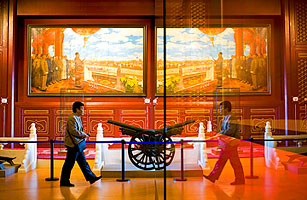
Spring flowers bloomed and soldiers could be seen goose-stepping across Tiananmen Square as I walked through the recently renovated National Museum in Beijing. A new exhibit, “The Road of Rejuvenation,” promised to highlight “the glorious history of China under the leadership of the Communist Party.” So what’s included in a permanent show that contains 2,220 “First-Rank Cultural Objects” and occupies roughly one-fifth of the massive museum’s exhibition space? I made my way through room after room of obscure communist artifacts, ranging from a medal awarded to the Chinese 1957 high-jump world-record holder to the gavel used to announce China’s 2001 entry into the World Trade Organization. One of the final displays was a glass case containing rotary phones, pagers and cell phones — even an iPhone 4. “This is dozens of communications equipment since reform and opening up,” read the accompanying English panel.
After a long, $380 million refurbishment, China’s National Museum fully reopened in April. It is now the biggest in the world, with 1.05 million cultural relics spread over 192,000 sq m of floor space — about 27 soccer fields. In a country obsessed with superlatives, this institution has big ambitions: to present China’s 5,000-year civilization — not to mention its more recent communist triumphs — in a sprawling structure that rivals St. Petersburg’s Hermitage Museum or Paris’ Louvre